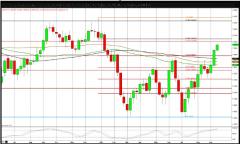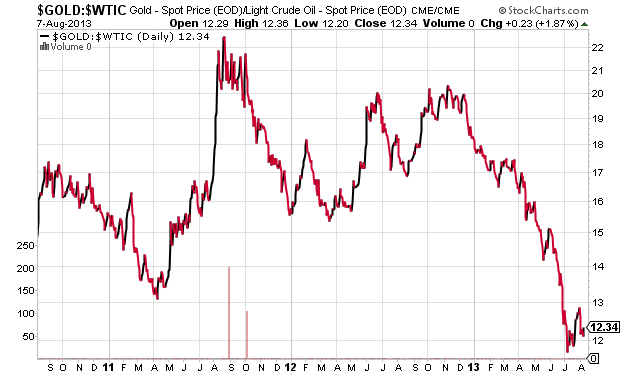On the back of three consecutive days of decent gains, U.S. stocks are taking a breather this morning, with the S&P 500 (SNPINDEX: ^GSPC ) and the narrower, price-weighted Dow Jones Industrial Average (DJINDICES: ^DJI ) down 0.6% and 0.79%, respectively, at 10:10 a.m. EDT.
"Risk-parity" funds get hit
More victims of the recent bout of volatility! The Wall Street Journal published a very interesting article on their website yesterday evening, according to which fashionable "risk parity" mutual funds have been hit hard�recently.
Imported from the hedge fund world with a basis in modern portfolio theory, risk-parity funds invest across multiple asset classes (stocks, bonds, commodities, etc.) and aim to achieve the highest returns possible with a specific level of volatility (i.e., the best "risk-adjusted" returns). Typically, the fund's manager does this by resorting to leverage and/or by actively reallocating among the different asset classes, instead of maintaining a fixed allocation.
Best High Tech Companies To Watch For 2014: AtriCure Inc.(ATRC)
AtriCure, Inc., a medical device company, develops, manufactures, and sells cardiac surgical ablation systems designed to create precise lesions, or scars, in cardiac tissue. Its primary product line includes isolator synergy bipolar radio-frequency ablation clamps for open-heart procedures and minimally invasive procedures; ablation and sensing unit, a compact power generator that delivers bipolar radio-frequency (RF) energy; AtriCure switch box, a compact switch box providing the technology needed for the dual pulsing electrodes, and the ability to connect and toggle between multiple RF devices; isolator multifunctional pen, a disposable RF device enabling surgeons to toggle back and forth between temporary pacing, sensing, and stimulation and ablation; and coolrail linear ablation device, a disposable linear RF ablation device, which allows physicians to create an expanded cardiac ablation lesion set during minimally invasive procedures. The company also offers cryoabla tion system, which consists of various reusable and disposable devices, including the Frigitronics CCS-200 product line for cardiac ablation; and Cryo1, a disposable cryoablation device, as well as AtriClip system, which is designed to exclude the left atrial appendage by implanting the device during concomitant open surgical procedures from the outside of the heart. In addition, it sells enabling technologies, including Lumitip dissector to separate tissues to provide access to key anatomical structures targeted for ablation; and MicroPace ORLab system, a stimulating, mapping, and recording system enabling physicians to confirm the ablation lines being created are forming electrical barriers or lines of block. The company sells its medical devices to hospitals and medical centers in the United States and internationally. AtriCure, Inc. is headquartered in West Chester, Ohio.
Best High Tech Companies To Watch For 2014: The Spectranetics Corporation (SPNC)
The Spectranetics Corporation designs, manufactures, and markets single use medical devices used in minimally invasive surgical procedures within the cardiovascular system in conjunction with its proprietary excimer laser system, the CVX-300. The company?s excimer laser technology is used to ablate multiple lesion morphology morphologies, such as plaque, moderate calcium, and thrombus. It offers four primary product categories for the Vascular Intervention product line, including peripheral atherectomy, coronary atherectomy, thrombus management, and crossing solutions. The peripheral atherectomy product line consists of a selection of proprietary laser catheters that are indicated for the treatment of infrainguinal (leg) stenoses and occlusions; and the coronary atherectomy product line includes a selection of proprietary laser catheters to be used in various types of coronary artery diseases comprising occluded saphenous vein bypass grafts, ostial lesions, long lesions, m oderately calcified stenoses, total occlusions traversable by guidewire, lesions, and restenosis. The thrombus management product line consists of three thrombus removal devices intended to remove fresh, soft thrombi, and emboli from vessels in the arterial system, as well as to address thrombotic occlusions in dialysis grafts and fistulae; and the crossing solutions product line support guidewires or other devices in facilitating vascular access in the arterial system to enable various types of interventions. The company?s lead management product line comprises excimer laser sheaths, non-laser sheaths, and cardiac lead management accessories for the removal of pacemaker and defibrillator cardiac leads. It sells its products in the United States, Canada, Europe, the Middle East, the Asia Pacific, Latin America, and Puerto Rico. The company has a strategic alliance with Kensey Nash Corporation. The Spectranetics Corporation was founded in 1984 and is based in Colorado Springs , Colorado.
Templeton Dragon Fund, Inc. is a closed ended equity mutual fund launched and managed by Templeton Asset Management Ltd. It invests in the public equity markets of China. The fund invests in stocks of companies operating across diversified sectors. It invests in value stocks of companies. The fund typically employs fundamental analysis focusing on factors like growth prospects, competitive positions in export markets, technologies, research and development, productivity, labor costs, raw material costs and sources, profit margins, returns on investment, capital resources, government regulation and management. Templeton Dragon Fund, Inc was formed on September 20. 1994 and is domiciled in Singapore.
Best High Tech Companies To Watch For 2014: China Xiniya Fashion Limited(XNY)
China Xiniya Fashion Limited engages in the design and manufacture of men?s business casual and business formal apparel and accessories. It offers business casual apparel, including jackets, pants, shirts, T-shirts, sweaters, and overcoats; business formal apparel comprising suits, business pants, and dress shirts; and accessories consisting of ties, bags, belts, and shoes. The company sells its products under the Xiniya brand name to distributors and department store chains in the People?s Republic of China. China Xiniya Fashion Limited was founded in 1993 and is headquartered in Jinjiang, the People?s Republic of China.
Best High Tech Companies To Watch For 2014: Saunders International Ltd(SND.AX)
Saunders International Limited designs, constructs, and maintains steel bulk liquid storage tanks and reservoirs in Australia. It constructs water reservoirs and petroleum tanks, as well as acid, bitumen, and chemical tanks. The company also offers facilities maintenance services, including risk based maintenance prioritizing, QA compliant inspection, decommissioning and recommissioning, in-house engineering analysis and workshop fabrication, mechanical repair, and preventative maintenance services. In addition, it provides steel fabrication services, which consists of rolling, pressing, abrasive blasting, and painting. The company offers its products to companies operating in petroleum, mining, mineral processing, manufacturing, water, and waste water sectors. Saunders International Limited was founded in 1951 and is headquartered in Condell Park, Australia.
Best High Tech Companies To Watch For 2014: Keryx Biopharmaceuticals Inc.(KERX)
Keryx Biopharmaceuticals, Inc., a biopharmaceutical company, together with its subsidiaries, focuses on the acquisition, development, and commercialization of pharmaceutical products for the treatment cancer and renal disease. The company?s products under development include KRX-0401 (perifosine), an oral anti-cancer agent that inhibits Akt activation in the phosphoinositide 3-kinase (PI3K) pathway, as well as affects other pathways associated with programmed cell death, cell growth, cell differentiation, and cell survival. Its KRX-0401 is in Phase III clinical development stage for the treatment of refractory advanced colorectal cancer and multiple myeloma, as well as in Phase I and Phase II clinical development stages for the treatment of other tumor types. The company is also developing Zerenex (ferric citrate), an oral, ferric iron-based compound that is in Phase III clinical development for the treatment of hyperphosphatemia in patients with end-stage renal disease o n dialysis. Keryx Biopharmaceuticals, Inc. has commercial license agreements with Zentaris AG for the development of KRX-0401; Panion & BF Biotech, Inc. for the development and marketing of Zerenex; and Japan Tobacco Inc. and Torii Pharmaceutical Co., Ltd. for the development and commercialization of Zerenex in Japan. The company was founded in 1997 and is based in New York, New York.
Best High Tech Companies To Watch For 2014: Metro Bancorp Inc(METR)
Metro Bancorp, Inc. operates as the bank holding company for Metro Bank, which provides a range of retail and commercial banking services to consumers and small and mid-sized companies in Pennsylvania. Its deposit products include personal and business checking accounts, regular savings accounts, money market accounts, interest checking accounts, fixed rate certificates of deposit, individual retirement accounts, and club accounts. The company?s loan products portfolio comprises commercial and industrial, owner occupied real estate, commercial construction and land development, and commercial real estate loans; consumer loans, including home equity, overdraft checking protection, and consumer credit cards, as well as installment loans for home improvement, and the purchase of consumer goods and automobiles; and construction loans and permanent mortgages for homes. It also offers debit card services, online banking services, safe deposit facilities, and automated teller fa cilities. As of July 14, 2011, Metro Bancorp operated 33 stores in the counties of Berks, Cumberland, Dauphin, Lancaster, Lebanon, and York. The company was formerly known as Pennsylvania Commerce Bancorp, Inc. and changed its name to Metro Bancorp, Inc. in June 2009. Metro Bancorp, Inc. was founded in 1984 and is headquartered in Harrisburg, Pennsylvania.
Best High Tech Companies To Watch For 2014: The Wharf (4)
The Wharf (Holdings) Limited is an investment holding company. It has four segments: property investment, which includes property leasing and hotel operations, and its properties portfolio consists of retail, office, service apartments and hotels, and is primarily located in Hong Kong and Mainland China; property development, which involves activities relating to the acquisition, development, design, construction, sale and marketing of its trading properties primarily in Hong Kong and Mainland China; logistics, which includes the container terminal operations undertaken by Modern Terminals Limited (Modern Terminals), Hong Kong Air Cargo Terminals Limited and other public transport operations, and communications, media and entertainment (CME), which comprises pay television, Internet and multimedia and other businesses operated by its non-wholly-owned subsidiary, i-CABLE Communications Limited and also includes the telecommunication businesses operated by Wharf T&T Limited.
 A company hoping to cash in on people’s fear of the potential doom facing the world are creating the perfect utopian world for doomsday survivalists.
A company hoping to cash in on people’s fear of the potential doom facing the world are creating the perfect utopian world for doomsday survivalists.
 The Booklight/Flickr Thousands of personal finance books on shelves today promise to teach you to spend less, save more, invest better, retire earlier, get out of debt faster, and solve just about every financial conundrum in between. But perhaps none said it better than a book published in 1937. Napoleon Hill, a Great Depression-era author and former adviser to President Franklin D. Roosevelt, interviewed "more than five hundred of the most successful men this country has ever known" to figure out the key to their good fortune. He wrapped all of his insights in a 200-page package and published "Think and Grow Rich," which went on to become one of the best-selling books of all time. Don't expect to find any stock-picking or gambling advice in it. Despite Hill interviewing some of the most iconic businessmen of his day, none of his findings involved any particularly hard-to-attain skills. His entire premise is helping people overcome the psychological barriers that keep them from wealth. "Wishing will not bring riches," Hill writes. "But desiring riches with a state of mind that becomes an obsession, then planning definite ways and means to acquire riches, and backing those plans with persistence which does not recognize failure, will bring riches." In one passage, he sums up six steps to turning a desire for wealth into "its financial equivalent":
The Booklight/Flickr Thousands of personal finance books on shelves today promise to teach you to spend less, save more, invest better, retire earlier, get out of debt faster, and solve just about every financial conundrum in between. But perhaps none said it better than a book published in 1937. Napoleon Hill, a Great Depression-era author and former adviser to President Franklin D. Roosevelt, interviewed "more than five hundred of the most successful men this country has ever known" to figure out the key to their good fortune. He wrapped all of his insights in a 200-page package and published "Think and Grow Rich," which went on to become one of the best-selling books of all time. Don't expect to find any stock-picking or gambling advice in it. Despite Hill interviewing some of the most iconic businessmen of his day, none of his findings involved any particularly hard-to-attain skills. His entire premise is helping people overcome the psychological barriers that keep them from wealth. "Wishing will not bring riches," Hill writes. "But desiring riches with a state of mind that becomes an obsession, then planning definite ways and means to acquire riches, and backing those plans with persistence which does not recognize failure, will bring riches." In one passage, he sums up six steps to turning a desire for wealth into "its financial equivalent": 

 AP
AP  Galley (left) said that this summer, “when interest rates sold off,” RiverNorth descried the increased discount to the value of the underlying assets in closed-end funds “go from boring to a very strong opportunity.” That opportunity is so strong, in fact, that the fund now has 33% of its holdings in each of the three sleeves. At inception, 50% of the fund’s holdings were in DoubleLine’s core fixed income sleeve. “We soft closed as opportunity shrunk; now we’ve shifted, finding new opportunity,” especially since “discount volatility is what we like at RiverNorth.”
Galley (left) said that this summer, “when interest rates sold off,” RiverNorth descried the increased discount to the value of the underlying assets in closed-end funds “go from boring to a very strong opportunity.” That opportunity is so strong, in fact, that the fund now has 33% of its holdings in each of the three sleeves. At inception, 50% of the fund’s holdings were in DoubleLine’s core fixed income sleeve. “We soft closed as opportunity shrunk; now we’ve shifted, finding new opportunity,” especially since “discount volatility is what we like at RiverNorth.” announcement came on the same day that Federal Reserve Chairman Ben Bernanke announced that the Fed would continue its monthly bond purchases at the same level, rather than start tapering those purchases. Saying the FOMC move made it likely that “zero interest rates are here to stay for a long time,” Gundlach said that in the “beginning of a cyclical change, closed-end funds might be more attractive than open-end funds; they’re already cheap, and may become cheaper than open-end funds or bonds themselves.”
announcement came on the same day that Federal Reserve Chairman Ben Bernanke announced that the Fed would continue its monthly bond purchases at the same level, rather than start tapering those purchases. Saying the FOMC move made it likely that “zero interest rates are here to stay for a long time,” Gundlach said that in the “beginning of a cyclical change, closed-end funds might be more attractive than open-end funds; they’re already cheap, and may become cheaper than open-end funds or bonds themselves.”

 ) revealed a slew of new products at this year’s Intel Developer Forum in San Francisco.
) revealed a slew of new products at this year’s Intel Developer Forum in San Francisco.




